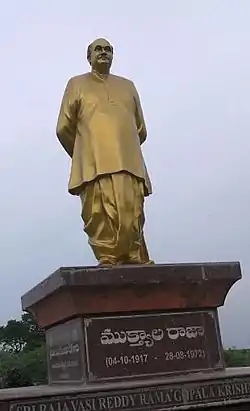Muktyala Raja
Raja Vasireddy Ramagopala Krishna Maheswara Prasad, popularly known as Muktyala Raja (4 October 1917 – 28 August 1972) was a Zamindar of Muktyala who is instrumental in the construction of the Nagarjuna Sagar Dam, the tallest masonry dam in the world, in the State of United Andhra Pradesh India, which is across the river Krishna.[1] He is the descendant of family of Vasireddy Venkatadri Nayudu.
Raja Vasireddy Ramagopala Krishna Maheswara Prasad | |
|---|---|
 Statue of Muktyala Raja at Nagarjuna Sagar project site. | |
| Born | 4 October 1917 |
| Died | 28 August 1972 (aged 54) |
| Nationality | Indian |
| Occupation | Zamindar of Muktyala |
| Known for | Nagarjuna Sagar Dam |
Achievements
He was born in Muktyala village of Krishna district in a Kamma family. The Raja of Muktyala strived hard for the construction of the Pulichintala Project across the river Krishna, a dream which has taken shape recently.[2] He came to know that the Government of Madras Presidency has made plans to divert Krishna river water to Madras by linking Krishna and Pennar rivers. He embarked upon a tour of nine districts of Andhra Pradesh and visited each and every village to collect the signatures of people in favour of Nagarjuna Sagar Dam project. He traveled through the thick and inhospitable jungles near Macherla to visit the site of Nandikonda and formed a team of retired engineers at his own expense to make the project plans and designs. The government of Madras tried to scuttle his plans for which the Raja established the 'Krishna Farmers Welfare Society' and exerted pressure on the Government of India in favour of the Nagarjuna Sagar Dam. The Government of India instituted the Khosla Committee but the committee refused to visit the site on the excuse that there was no motorable road to Nandikonda. The Raja gathered villagers and volunteers from twenty five villages and made a road by labouring day and night for a week at his own expense. The Khosla committee visited the site and found it to be the most ideal location to build a gigantic dam across the river.
There were attempts to suppress the report of the Khosla committee. The Raja went to New Delhi and with the support of N. G. Ranga, Moturi Hanumantha Rao and Kotha Raghuramaiah resurrected the report, distributed it to important people and urged the Planning Commission (Government of India) to take cognizance.
Chandulal Trivedi, the Governor of the state of Andhra Pradesh urged the Prime Minister Jawaharlal Nehru to accept the report of the Khosla Committee. An announcement was made in 1954 for the construction of the project. The foundation stone was laid on 10 December 1955. Raja donated fifty two lakh rupees and fifty five thousand acres of land as a matching grant for the project construction. The waters of Krishna river were released for the farmers on 3 August 1966.
References
| Wikimedia Commons has media related to Raja of Muktyala. |
- "Rich tributes paid to Muktyala Raja". The Hindu. 5 October 2012. Retrieved 5 October 2018.
- Rao, K.L., Cusecs Candidate: Memoirs of an Engineer, 1978, Metropolitan, p. 31; https://books.google.com/books?id=850aAAAAMAAJ&q=muktyala+raja&dq=muktyala+raja&pgis=1